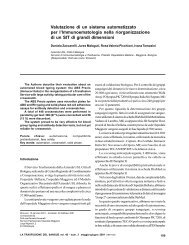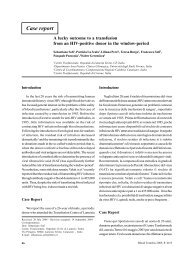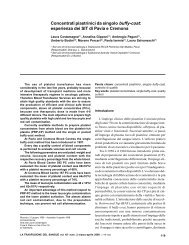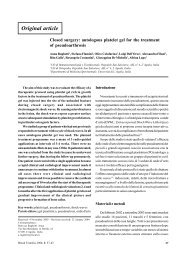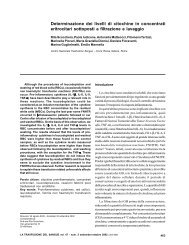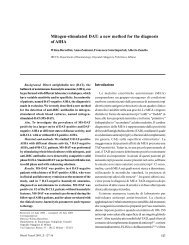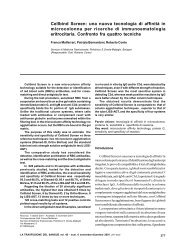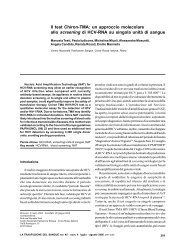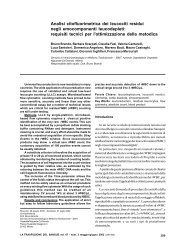Giampaolo A et al.Table III - Description of near miss errorsIn the wardSample taken from wrong person 36%Errors in data identifying the test-tube 12%Error in request form 17%Incongruities between data on request form <strong>and</strong> on test-tube 10%In the <strong>Transfusion</strong> StructureExchange of samples 10%Error during the stage of accepting the request in the management system 2.5%Mistaking one patient for another 2.5%Error in serological test in the laboratory 5%Issue of wrong units 2.5%Predeposited unit belonging to another patient sent to another TS 2.5%the ward at the time of the <strong>transfusion</strong>. In the sixreports in which the patients' outcome was described,one patient died, three had no consequences <strong>and</strong> twohad mild symptoms.Near miss errorsThere were 47 reports of near miss errors, that is,errors recognised before the <strong>transfusion</strong>. Six of theforms did not report the type of error that had occurred,the other forms described, for the most part (75%),errors occurring in the wards at the time of taking thesamples, errors in filling in the identifying data onthe test-tube, <strong>and</strong> errors in completing the requestform.The other 25% of the reports concerned errorsoccurring in the TS at the time of accepting the request<strong>and</strong> the samples, when issuing the units, <strong>and</strong> whenconducting serological tests in the laboratory. TableIII presents the various types of near miss errors indetail.Discussion <strong>and</strong> conclusionsThis study, the first Italian report on the notificationof adverse reactions to <strong>transfusion</strong>s, refers to years2004 <strong>and</strong> 2005 <strong>and</strong> concerns about 50% of all bloodcomponents distributed in the nation.In this first analysis of national haemovigilancedata it was considered useful to analyse both thePETRA forms that were received <strong>and</strong> the summarydata-sheets (concerning only the type of adversereaction) supplied by those regions, which, incompliance with Italian legislation, had already setup a system for recording <strong>transfusion</strong>s <strong>and</strong> notifyingadverse reactions. These different systems of reportingdid, however, lead to a lack of homogeneity in thenotifications, thus enabling only a partial analysis ofthe events notified. A more detailed analysis waspossible only of the PETRA forms.The notification form was designed by <strong>transfusion</strong><strong>medicine</strong> specialist <strong>and</strong> agreed upon consultatorymeetings with representatives of CRCC <strong>and</strong> othercomponents of the <strong>transfusion</strong> system. Health caremanagers were informed of the new haemovigilancesystem by the ISS <strong>and</strong> invited, as presidents of theCommittees on the Good Use of <strong>Blood</strong>, to spread theculture of haemovigilance <strong>and</strong> to encourage wards,in which blood products are used, to notify an adverseevents occurring after a <strong>transfusion</strong>.In 2005, 1,495 adverse reactions were notified,including those reported by TS not using PETRA.The TS participating, including those which declaredno <strong>transfusion</strong> reactions, had distributed 1,834,474units of blood components. Therefore, the reportedrate of reactions was 0.8/1,000 units. This isundoubtedly an underestimate, given that the Frenchsystem has consistently recorded about 3 adversereactions/1,000 units of blood components since1998 1 .The percentage of notifications varied greatly fromregion to region. The scarcity of notifications (underreporting)is a problem in all haemovigilance systems<strong>and</strong> can have various causes: the adverse reaction <strong>and</strong>/or its relation with the <strong>transfusion</strong> is not alwaysrecognised; when it is recognised, the importance ofnotifying it is not accepted as a tool to improve<strong>transfusion</strong> safety; staff may be afraid of disciplinaryaction in the case of notified errors.Almost all the adverse events notified were acutereactions, since only five delayed reactions werenotified. An almost complete lack of recording of latereactions (delayed haemolytic reactions, GvHD, post<strong>transfusion</strong>alpurpura, viral, bacterial <strong>and</strong> parasitic72<strong>Blood</strong> Transfus 2007; 5: 66-74 DOI 10.2450/2007.0001-07066-074_hassan.p65 7205/07/2007, 11.05
Haemovigilance in Italyinfections, haemochromatosis) was reported.InFrance, these reactions represent 35% of all theadverse events reported 1 .The lack of agreed definitions negatively affectsdata collection. For example, it would be useful tohave shared diagnostic criteria for TRALI, which is a<strong>transfusion</strong> reaction that is difficult to diagnose,because the symptoms can be very different <strong>and</strong> thereis not a specific diagnostic test. TRALI is included asan adverse reaction in the United Kingdomhaemovigilance system [Serious Hazards of<strong>Transfusion</strong> (SHOT)] which, between 1996 <strong>and</strong> 2004,reported 162 cases, of which 36 were fatal; of these,13 were considered probably or certainly due to the<strong>transfusion</strong>. In France, this adverse reaction was notdiagnosed until 2002 (although it was, perhaps,sometimes reported as volume overload). After aneffort of the haemovigilance system to improve thediagnosis of this reaction, TRALI is now betteridentified <strong>and</strong> studied. In 2003, 15 cases probably orcertainly due to <strong>transfusion</strong>s were identified, of whichthree were fatal. Only one case of TRALI was reportedin the Italian system, leading to the suspicion that thereis underreporting of this reaction, perhaps due in partto the difficulty in its diagnosis.The types of <strong>transfusion</strong> reactions were febrile in46.9% of the cases <strong>and</strong> allergic (urticaria <strong>and</strong>anaphylactic reactions) in 38.7%. The analysis of onlythose cases, in which the <strong>transfusion</strong> was certainly orprobably causal, notified with the PETRA system,showed opposite proportions of these two pathologies:46.5% of the reactions were of an allergic nature <strong>and</strong>about 34% were febrile-type reactions. Thesepercentages are in line with data reported by otherhaemovigilance systems.The promotion of a different culture, in whichnotifying errors is in some way fostered, is afundamental step in any attempt to identify <strong>and</strong> tacklesystem defects in the <strong>transfusion</strong> chain. Errors <strong>and</strong>near miss errors (the latter being more frequent)represent failures in the system <strong>and</strong> by analysing them,critical points to be kept under control can beidentified.It has emerged from the reports on haemovigilancein France <strong>and</strong> the United Kingdom that <strong>transfusion</strong>alerrors leading to ABO-incompatible <strong>transfusion</strong>srequire great attention. Up to 2002, the Frenchhaemovigilance system only recorded ABOincompatibilities that had a clinical effect; thenotification of clinical grade 0 errors was introducedonly subsequently, as an instrument to achieveimprovements, even in the absence of adversereactions.In Italy, as in other countries, a <strong>transfusion</strong> reactiondue to ABO incompatibility is considered a sentinelevent, which can <strong>and</strong> must be prevented."Recommendations for the prevention of <strong>transfusion</strong>reactions due to ABO incompatibility" has been issuedby the Ministry of Health (Office III – Quality ofactivities <strong>and</strong> services – General Management ofHealth Care Planning, levels of care <strong>and</strong> system ethicalprinciples).The regions of Veneto <strong>and</strong> Emilia Romagna wereparticularly active in notifying errors <strong>and</strong> near misserrors. Previous implementation of systems for clinicalrisk management <strong>and</strong> a culture of reporting adverseevents, with the aim of improving patient safety,increased participation to haemovigilance <strong>and</strong> enablebetter <strong>and</strong> greater integration of monitoring systems.Overall, there were nine reported cases of ABOincompatibility, of which one was fatal; all these caseswere due to an error in one of the critical steps ofidentifying the patient. These nine cases account for0.6% of the events notified.SHOT found that the overall number of errors wasequivalent to 70% of the events notified <strong>and</strong> that casesof ABO incompatibility accounted for 10% of theevents notified 2 . The need to educate <strong>and</strong> train staff isconsidered fundamental for the function of ahaemovigilance system. The data on errors should bemonitored for longer, in order that awareness of theimportance of notifying errors, by staff, can make thehaemovigilance system fully effective.Estimating the incidence of errors is essential tomonitor blood safety <strong>and</strong> to help health care managersto make informed decisions on systematicallyintroducing instruments for the identification ofpatients/units of blood components. These instrumentsare commercially available <strong>and</strong> already used in somehospitals.Compared to the organization of the <strong>transfusion</strong>system in other countries, in which blood banks arecompletely separate from hospitals, Italian TS arelocated within hospitals leading to a differentmanagement of blood units, presumably with a moreeffective traceability.Having overcome the problem of under-reporting,given that the incidence of errors is lower than that<strong>Blood</strong> Transfus 2007; 5: 66-74 DOI 10.2450/2007.0001-0773066-074_hassan.p65 7305/07/2007, 11.05



